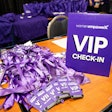One of the best ways to move the needle on your association's legislative priorities is to host a fly-in with your most well-versed, effective and persuasive members serving as your advocates on Capitol Hill. However, having a successful fly-in goes far beyond just getting those members to Washington, scheduling meetings and planning dinners and lunches.
Yes, those elements are important to the overall experience. After all, the happier your advocates are, the more effective they’ll be advocating for your positions. But getting the right meetings with the right people in the right congressional offices is paramount.
Here’s how you plan a successful fly-in for your association:
Step 1: Request Meetings in the Appropriate Timeframe
Congressional offices receive requests for meetings constantly and most have a particular system for fielding these requests that you must observe. At the same time, their schedules can change quickly so planning for three or more months out may sound like a good idea but won't get you the face time you want.
Rather than focusing on the representative him or herself, reach out to the scheduler or junior staffer for a meeting about three weeks (yes, weeks) in advance following the protocol their office requires.
Step 2: Be Tactful in Your Follow Up
If you haven’t heard back from the office about your request, chances are it’s still in review. Again, every office is flooded with meeting requests and the member’s staff has to evaluate each and decide what is worth scheduling a meeting to discuss.
This further underlines the importance of being specific in your meeting request—i.e. why should the member bother giving you time?—as well as being clear about what you want to come from the meeting.
Once you’ve done both of those things, wait at least one week from the initial request before following up—that burden is on you. When you do, acknowledge awareness of the influx of requests received and offer further information about why the meeting is worth the member’s or junior staffer’s, time. This should be already available in the original meeting request. If you do not have constituents, lower your expectations of having a meeting request granted.
Step 3: Train Your Advocates
Oftentimes you’ve got 10 to 15 minutes of face time to get your association's message across. That means whichever constituent advocates you send to the meeting need to be able to convey a message quickly, effectively and it needs to resonate with the office.
Schedule time at the beginning of the fly-in for the advocate teams (usually four to six people for each meeting booked) to greet each other and decide on conversation topics during the meeting with the congressional office.
This is also when to ensure they accurately understand your association’s position on the topics being discussed as well as the position of the office they are meeting with. The latter is key to them being able to field additional questions or sidetracking that member or staffer may throw at them.
During the preparation, be sure your advocates all know to stick to the topics in the original meeting request. This doesn’t have to be landmark legislation. It can be asking a question at a hearing, circulating a letter, holding a hearing about the topic on hand, or talking to another congressional office to learn more about others points of view on the subject.
Whatever the goal, the team needs to be well versed and ready to handle questions and distractions without letting emotion come into play when challenged on their position or the issue as a whole. Combative or ill-informed advocates who can easily get sidetracked by small talk will sink your fly-in’s success.
Step 4: Plan Social Engagement Options on the Side
Sometimes getting even 30 minutes of a member’s time isn’t possible with his or her schedule. However, if there is a lower pressure social engagement (award presentation, breakfast, reception, briefing, volunteer opportunity, etc.) they could stop in for a few minutes, you may still be able to get your facetime.
This ancillary social event provides a more relaxed setting for building the relationship that will:
- Help your organization in the short run (during the fly-in)
- Lay the groundwork for the long run goals of your organization (after advocates leave and the association’s work continues.)
- Still allows an opportunity to meet with constituents (i.e. your advocates.)
Be sure to mention that additional guests beyond the invited party are welcome. Whether it’s the member, scheduler or junior staffer who’s invited, (all of whom are good contacts for your organization), the chances of attendance increase when they can bring a plus one.
Point to note: "In addition, evening activities off the Hill should be incorporated into your schedule for the advocates to continue networking with one another and their spouses who may also be in attendance on these trips though not participating in the daytime agenda."
Step 5: Post-Meeting Follow Up
After the fly in is over, the follow ups from your association office should extend to both the congressional offices met with as well as the advocates who came in to represent your interests.
For the former, have advocates reach out directly to a staffer or if they had a member level meeting, the scheduler and staffer with the relevant portfolio, providing digital versions of the materials, research and facts discussed.
Advocates also need to know their time in Washington was well spent. Share stats with them about the total number of meetings, attendees, teams, etc. and any response that has come to your organization from those meetings. Sharing this information will encourage them to keep up the advocacy work from afar and increase their desire to come back in the future.















